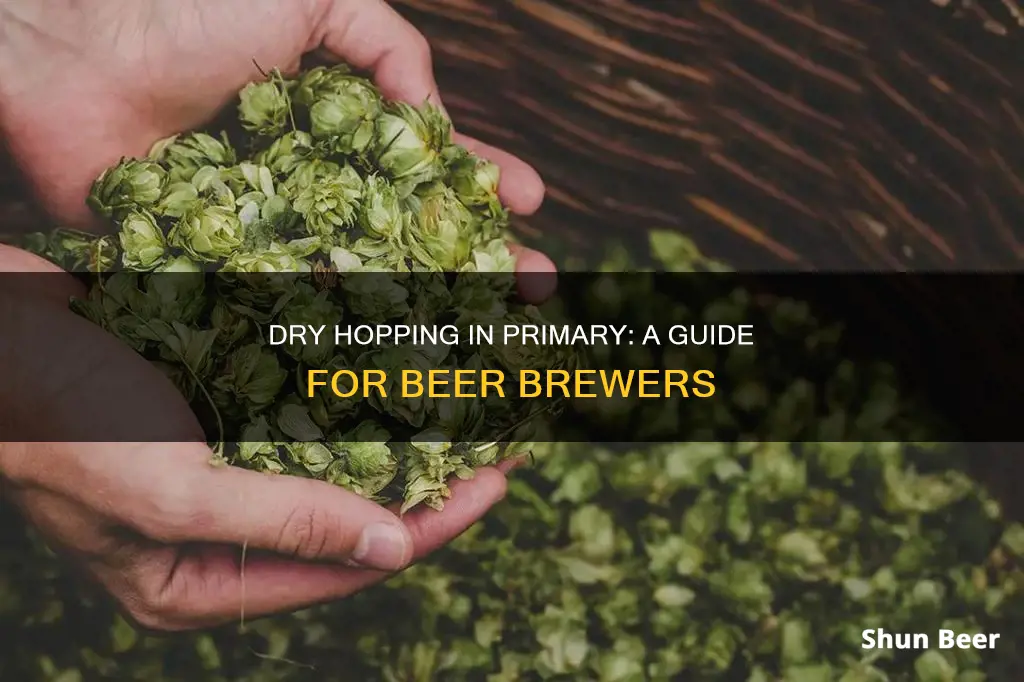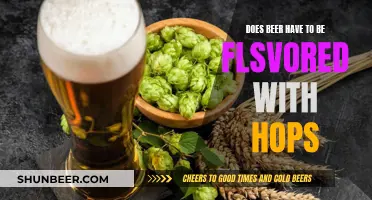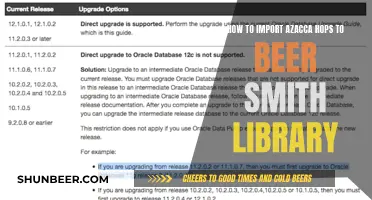
Dry hopping is the process of adding hops to beer during or after primary fermentation. This technique is used to add aroma and flavour to the beer without increasing bitterness. The hops can be added directly to the beer or contained in a bag. The amount of hops added depends on the desired aroma and the variety of hops used. While dry hopping can be done in the primary fermenter, it is more commonly done in the secondary fermenter to reduce the risk of CO2 bubbles carrying away the aroma compounds.
| Characteristics | Values |
|---|---|
| When to dry hop | During or after primary fermentation |
| Hops type | Dried whole leaf or T-90 pellets |
| Amount | 0.5-4 oz per 5-gallon batch |
| Temperature | Under 60ºF or as low as 34-39ºF (1-4ºC) |
| Time | 24-72 hours |
What You'll Learn

Dry hopping during primary fermentation
When dry hopping during primary fermentation, it is essential to choose the right type of hops. Aroma-forward hops, such as Cascade, Centennial, Amarillo, and Simcoe, are commonly used for West Coast or American IPAs. For tropical NEIPAs, Citra, Mosaic, and Galaxy hops are popular choices. The amount of hops required will depend on the desired strength of the aroma, with more hops needed for a stronger scent. It is important to note that dry hopping during primary fermentation will require more hops compared to secondary fermentation due to the CO2 scrubbing away the hops' aromas.
The process of dry hopping during primary fermentation involves sorting and preparing the hops or hop pellets and placing them into a sanitized bag or tube. The hops are then gently added to the fermenter, ensuring minimal splashing. The hops will need to remain in the beer for several days, typically a maximum of 7 days, before they are removed. After the hops are removed, the beer is ready for bottling or can be transferred to secondary fermentation if desired.
While dry hopping during primary fermentation can be more challenging and requires more hops, it offers brewers the opportunity to extract surprisingly different aromas, flavors, and appearances from their beers. This technique is worth exploring for those who are experimentally minded and looking to create unique and distinctive craft beers.
Gose Beer and Hops: An Unlikely Friendship
You may want to see also

Dry hopping after fermentation
The biggest risk of dry hopping after fermentation is introducing unwanted oxygen, which can cause oxidation. To prevent this, you can use a custom-built hop dropper, which will allow you to purge the hops with CO2 before they are added to the beer.
Another risk is "hop creep", which is a phenomenon where dry-hopping results in more fermentation, leading to a higher alcoholic beer than intended. To prevent this, simply lower the fermentation temperature to 14.5°C (58°F).
There are a few different ways to add hops to your beer after fermentation. One way is to add them directly to the fermenter, either loose or contained in a muslin/nylon bag or stainless steel mesh tube. This method will give you the most hop flavour and aroma, but it can also add oxygen to the beer, which can cause oxidation.
Another way to add hops after fermentation is to use a Randall or Hop Rocket, which is a hop infuser that allows you to run chilled wort through the hops before it enters the fermenter. This method has the benefit of less hop cleanup after fermentation.
When dry hopping after fermentation, it is generally recommended to use between 0.5 and 4 ounces of hops per 5-gallon batch, depending on the variety of hop and your personal preference. The hops should be left in contact with the beer for at least 48-72 hours to allow the aroma and flavour to infuse, but no longer than 2-3 weeks, as this can result in vegetal flavours such as grassy notes or other off-flavours.
Brewing Beer: Hops Quantity for Best Results
You may want to see also

Using whole leaf or pellet hops
Dry hopping is the process of adding hops to beer during or after primary fermentation. It adds aroma and flavour without increasing bitterness. Hops contain alpha acids, which, when heated during the boil, undergo isomerization, creating the bitter flavour in beer. Dry hopping preserves the delicate volatile oils that produce flavour and aroma.
You can use both whole leaf and pellet hops for dry hopping. Leaf hops will float on top of the liquid, while pellet hops will disintegrate into a sludge that sinks to the bottom. Pellet hops are more convenient and readily available, but they can cause a sudden eruption of foam when added to a full container. They also require a straining bag or strainer to reduce the amount of hops in the finished beer. Leaf hops take up more space in the fermenter and soak up more beer, decreasing the overall yield. Commercial breweries tend to use pellet hops because of their advantages in shelf life, efficiency, and reduced beer absorption.
The amount of hops used in a 5-gallon batch can vary depending on the desired aroma intensity and the gravity of the beer. A general rule of thumb for an average amount of aroma is one ounce in 5 gallons of average-strength beer. For more hop aroma or in higher-gravity beers, you can use up to 4-5 ounces in 5 gallons or even more if you want to push the boundaries. It is recommended to dry hop at temperatures between 60°F and 70°F for 10 to 14 days. At lower temperatures of 40°-50°F, it may take 3-4 weeks to extract the essential oils from the hops.
Choosing Hops for Beer: A Guide to Aromatic Excellence
You may want to see also

How long to dry hop for
Dry hopping is the process of adding hops to beer during or right after primary fermentation. It adds aroma and flavour without any bitterness.
There are differing opinions on how long to dry hop for. Some sources suggest 2-3 days, others say 2-4 days, and some say 3-5 days. It is generally agreed that after a few days, there is nothing to be gained by extending the time in contact with the hops. In fact, one source says that after 3-7 days in the keg, the hops can start to negatively impact the beer's flavour.
The length of time you dry hop for will depend on the type of hops you are using. Pellet and plug hops release their extract at different rates. Aroma compounds in pelletized hops are extracted in as little as a day or two, whereas whole cones can take a week or more.
Hemp and Hops: Exploring the Botanical Cousins
You may want to see also

Choosing the right hop variety
When it comes to choosing the right hop variety for dry hopping, there are a few things to consider. Firstly, it is recommended to use hops that are considered "aroma" or "flavour" hops, which typically have relatively low alpha acid ratings. Examples of aroma hops include Cascade, Crystal, Willamette, East Kent Golding, Fuggle, Saaz, Hallertau and Tettnanger. These hops will add complex aromas to your brew, such as fruity or vegetal flavours. On the other hand, flavour hops such as Millennium, California Cluster, or Pacific Sunrise will release flavour compounds, but should be used carefully to avoid unpleasant bitterness.
Another factor to consider is the form of the hops. Whole cone hops are traditional but can be challenging to work with as they absorb a lot of beer and can add vegetal flavours while sapping fruit aromas. Pellet hops, on the other hand, are easy to work with, cheap, and allow for better circulation of wort, leading to more effective extraction of essential oils. Cryo hops are frozen whole hops that result in a brighter, pale ale-like brew and are more potent, so less is needed.
When choosing which specific hop variety to use, it is recommended to use the same hops that were added to the recipe as aroma hops, or a complementary hop. For example, if Centennial hops were used in the recipe, try dry hopping with another "C" hop such as Cascade or Citra, as the citrus aromas will work well together.
Additionally, it is generally recommended to use lower alpha acid hops when possible, as they have a higher percentage of delicate aroma oils. However, this is not a hard rule, and good results can be achieved with higher alpha acid hops as well. Ultimately, the choice of hop variety depends on personal preference and the desired flavour profile of the beer.
Hops and Cannabis: THC in Beer Explored
You may want to see also
Frequently asked questions
Dry hopping is the process of adding hops during or right after primary fermentation. It adds aroma and flavour without any bitterness to your beer.
Dry hopping can be done during primary fermentation, after fermentation, or in the keg. Dry hopping during primary fermentation is common practice with IPA brewers.
You can use either whole leaf or pellet hops for dry hopping. Pellet hops are more convenient and readily available, whereas leaf hops take up more space in the fermenter.
The amount of hops used depends on the desired aroma and the strength of the beer. A general rule of thumb is to use one ounce of hops for every five gallons of average-strength beer. For more hop aroma or stronger beers, you can use up to four to five ounces per five gallons.
Dry hopping can be done for 24 to 72 hours, with some brewers leaving the hops in for the entire secondary fermentation. However, leaving the hops in for longer than two to three weeks may result in vegetal flavours such as "grassy" notes or other off flavours.







